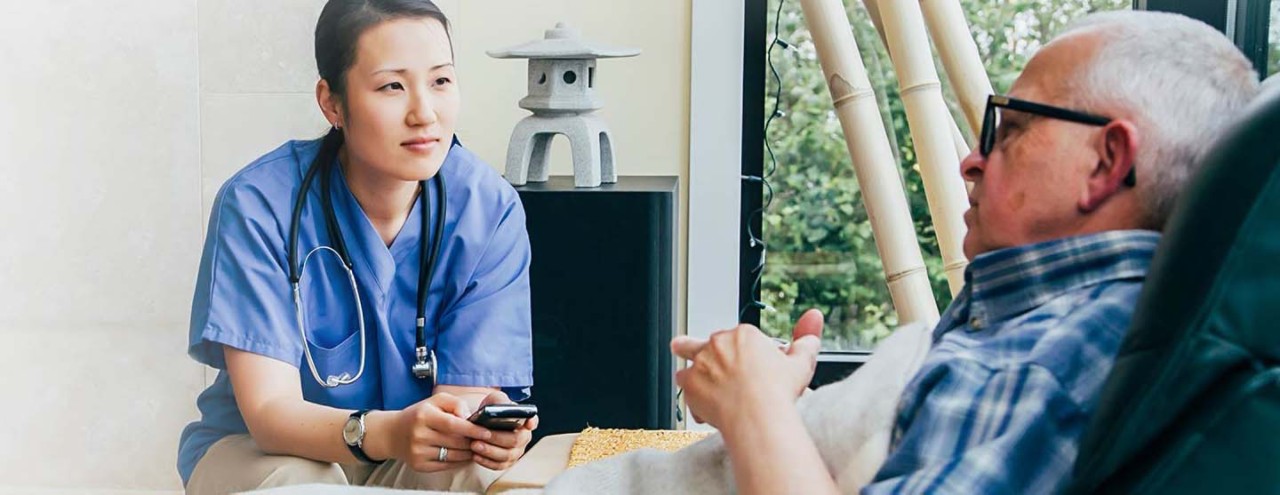
Health equity is defined as the state in which every person can achieve their full health potential.1 But inequity persists and disproportionately affects already underserved and Black, Indigenous, and people of color (BIPOC) communities. In the U.S., racial and ethnic minorities have worse overall health than that of white Americans.2 And among those populations diseases like diabetes and hypertension have long-term, potentially catastrophic health and financial impacts.3
Because inequity in healthcare is so pervasive and destructive among underserved and minority communities, we need innovative solutions to accelerate access and remove structural and societal barriers to quality care. We’re addressing some of these challenges by:
- Designing scalable, sustainable, and measurable partnerships and initiatives that remove bias and barriers to healthcare technology
- Partnering with health systems to identify populations most in need using data analytics and AI
- Increasing diverse representation in healthcare and science, technology, engineering, and math (STEM) programs
Through dedicated efforts we can help create lasting solutions that positively impact underserved and minority communities and lead to better outcomes for our world.
Hear how Medtronic is tackling health inequities from the leaders of the Medtronic Health Equity Advisory Committee.

Representation matters
It takes a combination of care and cultural and societal understanding to create the critical formula for quality patient health. Part of that understanding for medical teams is knowing how diverse representation can impact certain patient populations. It helps to have representation from all communities within medical fields. Right now, this is not the case. Harvard Business Review reported Black Americans make up 13% of the U.S. population but only 4% of U.S. doctors and less than 7% of U.S. medical students.4 Studies show that closing this and other representation gaps could save lives.5,6
The healthcare industry can address healthcare disparities by prioritising equal career advancement for women and people of color in STEM fields, as well as through physician and patient education. Our programs, partnerships, and initiatives offer a path to progress including:
- The Thurgood Marshall College Fund: This partnership is part of a larger effort by the Medtronic Foundation to elevate its focus on STEM and promote equity and representation for underserved and minority communities. Providing scholarships for low-income students pursuing STEM degrees at historically Black colleges and universities (HBCUs) propels the Medtronic Foundation toward the goal of improving the lives of those students. As part of the program, a Medtronic employee volunteer is paired with a scholarship recipient to mentor the STEM leaders of tomorrow. “To know a company like Medtronic that uses the principles that I hold dear in science, technology, engineering, and math to give back to people who are in situations like mine, it means a lot,” said Matthew Cofer, a Howard University engineering student.
- Society of Hispanic Professional Engineers (SHPE): Medtronic and the Medtronic Foundation are partnering with SHPE to launch a new college program that helps remove barriers to STEM education for Hispanic and Latino students. This partnership is committing over $3 million over the next four years for scholarships, internships, and mentorship opportunities for qualified SHPE students.
- STEM outreach to kids: To help advance diverse representation into STEM fields, we are offering knowledge, experiences, and expertise to inspire youth interest in STEM careers. We host these programs around the world, from Australia to the U.S. In addition, the Medtronic Foundation recently launched new STEM partnerships to address the root cause of persistent inequities by creating opportunity for economic advancement and improve lives through STEM education. The partnerships will serve over 60,000 underserved and underrepresented K-12 students in Minnesota, Northern California and Puerto Rico.
- Diverse representation in clinical trials: Focusing on gender, racial, and ethnic diversity, we’re increasing trial representation to ensure our innovations can benefit every patient. Specifically, we intend to create U.S.-based programs to encourage balance in gender enrollment and remove participation barriers for underserved and racial minority groups.
Empowering change
Strengthening health systems that enable every patient to achieve their full health potential is not easy. Patients must be able to navigate healthcare systems, identify health problems, and know what treatment options are available through trusted, culturally competent sources. Analysing data that’s focused on disparities in healthcare can enable actionable insights that empower healthcare workers and patients. Using technology-based healthcare solutions, we can continuously identify ways to improve care for underserved and minority populations.
Reaching more with lifesaving cancer screenings
Colorectal cancer is the third most common7 and second deadliest cancer among adults in the U.S., and Black adults are 20% more likely to be diagnosed and 40% more likely to die from this disease than any other population.8 There are also disparities in screenings among different groups, including adults in rural communities.9
Medtronic is providing artificial intelligence (AI)-assisted colonoscopy technology to underserved communities through the Medtronic Health Equity Assistance Program, announced in early 2022. We’re donating Medtronic GI Genius™ intelligent endoscopy modules to endoscopy centers across the country, with the support of Amazon Web Services (AWS). This technology can enable early detection, giving patients a better chance of survival – potentially impacting more than 350,000 patients over three years. This is an important step towards ensuring that our powerful technologies help reduce disparities, improve care, and enhance patient outcomes. Learn more about this initiative here.

Making innovation a part of aortic stenosis treatment for all
More than 20% of Americans over the age of 65 have aortic stenosis (AS),10 a narrowing of the aortic valve opening that restricts blood flow in the heart. Transcatheter Aortic Valve Replacement (TAVR) therapy is a minimally invasive procedure to replace the aortic valve. It's a life-saving option for many with AS.
However, patients of color are offered this minimally invasive option at significantly lower rates. While racial and ethnic minorities make up 23% of the 65 or older population in the U.S., just 8.7% of those patients can access TAVR.11
In early 2020, Medtronic launched the Addressing Disparities of Care in the Treatment of Aortic Stenosis Project. We partnered with several health systems to explore the root causes of these disparities and are launching programs to address barriers to treatment in African American, Latino-Hispanic, and Native American patients. The coalition will use data collection and education to help build a more equitable system.

Meeting hypertension patients where they live
Among cardiovascular diseases, hypertension is another that has had a sustained and damaging effect on the Black community. According to the CDC, 58.6% of Black men and over 57.6 % of Black women aged 20 and over have high blood pressure.12
Medtronic LABS, an independent, non-profit organisation with multiple entities including an operating foundation, a social business, and in-country subsidiaries, designs and implements tech-powered healthcare delivery models for underserved chronic disease patients in Asia and Africa. The organisation integrates digital technology, community health workers, and partnerships with health systems, governments, and others to drive sustainable health outcomes in low-resourced settings. Now their reach is expanding within the U.S. to communities in New Jersey where hypertension is prevalent.
Camden County, New Jersey is home to a population that is 20% uninsured, and chronic disease is overrepresented with 32.4% people suffering from high blood pressure.13 Through a community-based initiative, Medtronic LABS will facilitate two pilot programs as part of a collaboration with a local health system. The collaboration will focus on improving access and delivery of high-quality healthcare for patients with chronic conditions. Through combined resources and expertise, the pilot aims to convert unique clinical insights into promising new care delivery approaches aimed at increasing access and reducing healthcare costs.

Advocating for better diabetes care
In underserved and minority communities in the U.S., diabetes is among the most prevalent of the chronic diseases. More than 18% of all African Americans over 20 years old, have been diagnosed or have undiagnosed diabetes and close to 12% of Hispanic of the same age have been diagnosed with the illness.14 Despite the disproportionate number of cases, studies have shown that Hispanic and Black people with diabetes are two and three times less likely to use technology-based solutions than white diabetes patients.15
Medtronic is committed to reducing this gap. We are introducing unconscious bias training to help clinicians become better patient advocates. The training includes appointment checklists to make sure all treatment options are shared. We are also partnering with diabetes centres that serve mostly Spanish-speaking patients. These partnerships help patients gain access to education, support materials, and classes in Spanish to ensure they have the tools to set up their technology.
Engineering quality care for all
Widening health disparities puts quality care out of reach for too many U.S. communities. But we are committing our innovation and expanding our partnerships to help close the gap. Technology, representation, and access to both are essential to progressing past systematic healthcare challenges in underserved and racial minority communities. In a published white paper on telehealth and equity, VP and General Manager of Care Management Services, Sheri Dodd said, “If healthcare was empowering, holistic, and outcomes-driven – and emphasised the experience of the patient all the way through – digital health technologies would be designed very differently.” By creating and sustaining strategic initiatives that empower healthcare providers and patients, our hope is that we help them achieve positive outcomes that lead to restored health and extended life.
- Center for Disease Control and Prevention. www.cdc.gov/chronicdisease/healthequity/index.htm. Accessed Nov. 3, 2021
- Bahls C. Achieving Equity in Health. Health Affairs. 2011; doi. 10.1377/hpb20111006.957918
- Zhuo X, Zhang P, Barker L, Albright A, Thompson TJ, Gregg E. The Lifetime Cost of Diabetes and Its Implications for Diabetes Prevention. Diabetes Care. 2014; 37(9): 2557–2564
- New Jersey State Health Assessment Data. https://www-doh.state.nj.us/doh-shad. Accessed November 2021.
- Torres N. Research: Having a Black Doctor Led Black Men to Receive More-Effective Care. Harvard Business Review. https://hbr.org/2018/08/research-having-a-black-doctor-led-black-men-to-receive-more-effective-care. Published Aug. 10, 2018.
- Jackson CS, Gracia JN. Addressing Health and Health-Care Disparities: The Role of a Diverse Workforce and the Social Determinants of Health. Public Health Rep. 2014; 129(Suppl 2): 57–61. doi: 1177/00333549141291S211
- https://seer.cancer.gov/statfacts/html/colorect.html
- https://www.cancer.org/latest-news/colorectal-cancer-rates-higher-in-african-americans-rising-in-younger-people.html
- https://www.cdc.gov/ruralhealth/php/index.html
- American Heart Association. https://www.heart.org/en/health-topics/heart-valve-problems-and-disease/heart-valve-problems-and-causes/problem-aortic-valve-stenosis. Accessed November 2020.
- Alkhouli M, Vemulapalli S, Holmes DR, et al. Racial Disparities in the Utilization and Outcomes of TAVR: TVT Registry Report. JACC Cardiovasc Interv. 2019;12(10):936-948
- Nair L, Adetayo OA. Cultural Competence and Ethnic Diversity in Healthcare. Plast Reconstr Surg Glob Open. 2019; 7(5): e2219. doi: 10.1097/GOX.0000000000002219
- New Jersey State Health Assessment Data. https://www-doh.state.nj.us/doh-shad. Accessed November 2021.
- Chow EA, Foster H, Gonzalez V. McIver L. The Disparate Impact of Diabetes on Racial/Ethnic Minority. Clinical Diabetes 2012; 30(3): 130–133. doi.org/10.2337/diaclin.30.3.130
- Agarwal S, Kanapka LG, Raymond JK, et al. Racial-Ethnic Inequity in Young Adults with Type 1 Diabetes. Jour Clin Endo Meta. 2020; 105(8). e2960—e2969.
Explore topics:





